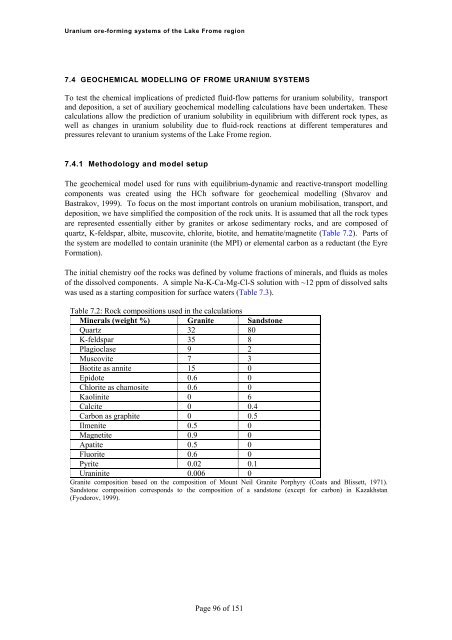Uranium ore-forming systems of the - Geoscience Australia
Uranium ore-forming systems of the - Geoscience Australia
Uranium ore-forming systems of the - Geoscience Australia
You also want an ePaper? Increase the reach of your titles
YUMPU automatically turns print PDFs into web optimized ePapers that Google loves.
<strong>Uranium</strong> <strong>ore</strong>-<strong>forming</strong> <strong>systems</strong> <strong>of</strong> <strong>the</strong> Lake Frome region7.4 GEOCHEMICAL MODELLING OF FROME URANIUM SYSTEMSTo test <strong>the</strong> chemical implications <strong>of</strong> predicted fluid-flow patterns for uranium solubility, transportand deposition, a set <strong>of</strong> auxiliary geochemical modelling calculations have been undertaken. Thesecalculations allow <strong>the</strong> prediction <strong>of</strong> uranium solubility in equilibrium with different rock types, aswell as changes in uranium solubility due to fluid-rock reactions at different temperatures andpressures relevant to uranium <strong>systems</strong> <strong>of</strong> <strong>the</strong> Lake Frome region.7.4.1 Methodology and model setupThe geochemical model used for runs with equilibrium-dynamic and reactive-transport modellingcomponents was created using <strong>the</strong> HCh s<strong>of</strong>tware for geochemical modelling (Shvarov andBastrakov, 1999). To focus on <strong>the</strong> most important controls on uranium mobilisation, transport, anddeposition, we have simplified <strong>the</strong> composition <strong>of</strong> <strong>the</strong> rock units. It is assumed that all <strong>the</strong> rock typesare represented essentially ei<strong>the</strong>r by granites or arkose sedimentary rocks, and are composed <strong>of</strong>quartz, K-feldspar, albite, muscovite, chlorite, biotite, and hematite/magnetite (Table 7.2). Parts <strong>of</strong><strong>the</strong> system are modelled to contain uraninite (<strong>the</strong> MPI) or elemental carbon as a reductant (<strong>the</strong> EyreFormation).The initial chemistry o<strong>of</strong> <strong>the</strong> rocks was defined by volume fractions <strong>of</strong> minerals, and fluids as moles<strong>of</strong> <strong>the</strong> dissolved components. A simple Na-K-Ca-Mg-Cl-S solution with ~12 ppm <strong>of</strong> dissolved saltswas used as a starting composition for surface waters (Table 7.3).Table 7.2: Rock compositions used in <strong>the</strong> calculationsMinerals (weight %) Granite SandstoneQuartz 32 80K-feldspar 35 8Plagioclase 9 2Muscovite 7 3Biotite as annite 15 0Epidote 0.6 0Chlorite as chamosite 0.6 0Kaolinite 0 6Calcite 0 0.4Carbon as graphite 0 0.5Ilmenite 0.5 0Magnetite 0.9 0Apatite 0.5 0Fluorite 0.6 0Pyrite 0.02 0.1Uraninite 0.006 0Granite composition based on <strong>the</strong> composition <strong>of</strong> Mount Neil Granite Porphyry (Coats and Blissett, 1971).Sandstone composition corresponds to <strong>the</strong> composition <strong>of</strong> a sandstone (except for carbon) in Kazakhstan(Fyodorov, 1999).Page 96 <strong>of</strong> 151
















